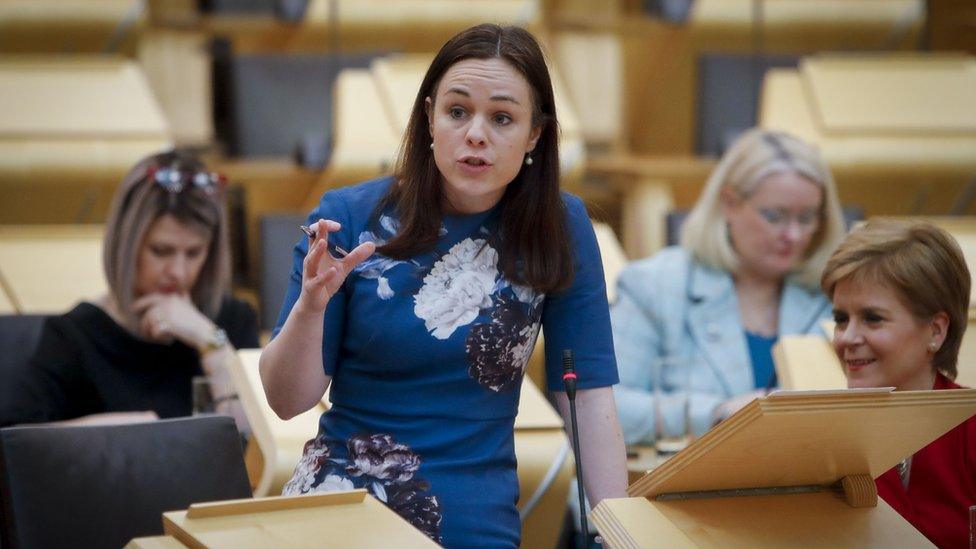Scottish budget: Holyrood passes tax and spending plans
- Published

Kate Forbes stepped in to deliver the budget after the resignation of Derek Mackay
The Scottish government's £40bn budget for the coming year has been formally signed off by MSPs.
The plans will see income tax rates in Scotland stay the same, although the threshold where the upper rates kick in will be frozen.
Extra funding will also go towards health, education and tackling the "climate emergency".
The budget was passed by 63 votes to 55 in a Scottish Parliament vote on Thursday afternoon.
The proposals will see the government set up a free bus travel scheme for under-19s by January of next year, which will be in addition to the existing free bus trips for the over-60s.
It formed part of a deal struck by the minority SNP government in return for the support of the Scottish Greens, which also included an extra £95m going to local authorities, as well as £18m to police services and £45m to low carbon projects.
The government has also agreed to review plans to upgrade the Sheriffhall roundabout on the Edinburgh bypass, although ministers have rejected calls from the Greens to scrap works on the A9 and A96.
The negotiations over the deal were led by Finance Secretary Kate Forbes, who was appointed to the role after Derek Mackay quit just hours before he was due to make his budget speech on 6 February.
His resignation came after Mr Mackay admitted behaving "foolishly" by sending 270 messages to a teenage boy on social media, including one which described the schoolboy as "cute".
Ms Forbes said: "I'm pleased that Parliament has supported this budget which will deliver certainty for our vital public services and local government.
"It supports our ambitious plans to accelerate Scotland's transition to a net-zero economy and provides a record £15bn investment for health and social care.
"It will also help us tackle inequalities, deliver first-class public services and ensure no taxpayer in Scotland will pay more income tax on their current income."
Opposition parties have said the spending plans fall short of what Scotland's economy and public services need, with the Scottish Conservatives accusing the SNP and Greens of delivering a "pay more, get less" budget for the people of Scotland.
Conservative finance spokesman Donald Cameron said: "It is a budget that underfunds our vital public services, especially local councils.
"And despite the drugs deaths crisis, it completely neglects the wellbeing of vulnerable addicts who need rehabilitation beds to turn their lives around."
Scottish Labour said the budget would inflict further and deeper cuts on Scotland's councils, but the Greens said the "historic" new bus travel scheme would "benefit 700,000 young people across Scotland and their families from next year".
What is in the budget?
Under the plans, Scotland's current tax rates will not increase and the threshold at which people start paying the basic and intermediate rates will increase by the rate of inflation.
The thresholds for the higher and upper rates will be frozen, with Ms Forbes calling this the "fairest and most progressive income tax system in the UK".
Among the spending commitments in the budget are:
More than £15bn for health and care services
£117m of investment in mental health support
A real-terms increase in revenue funding for councils
£180m for closing the attainment gap in schools
£270m for rail services
A 60% boost in funding to reduce harm from alcohol and drugs
The budget had a particular focus on environmental issues, with Ms Forbes saying it would "step up the delivery of our ambition to tackle climate change".
This includes £1.8bn of capital investment in projects to reduce emissions, and funding for active travel, electric vehicles, agriculture and peatland restoration.